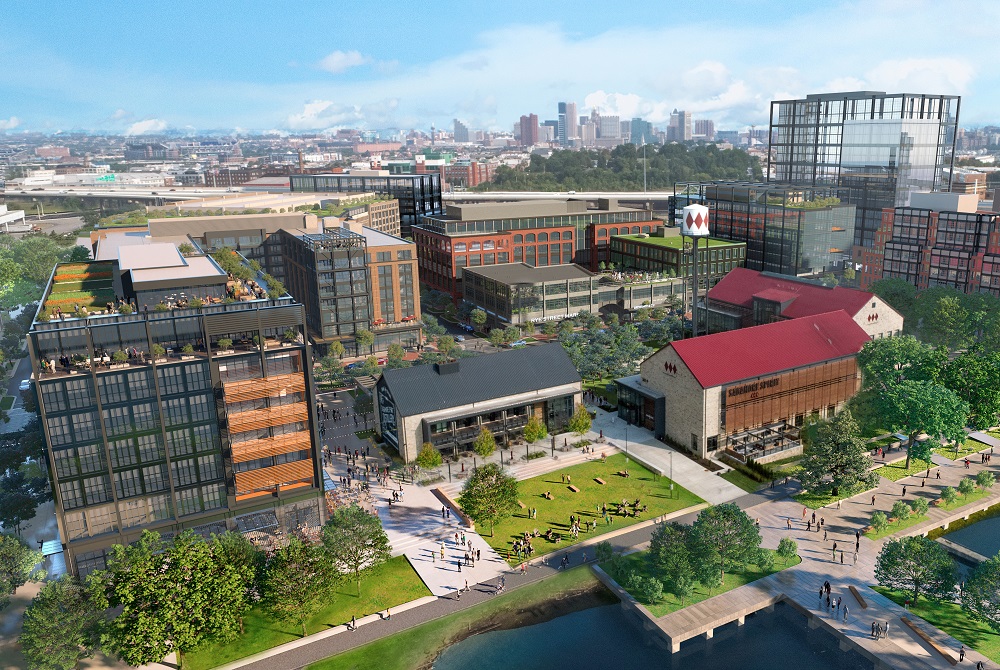
Weller Development Co. is the lead developer on Port Covington, a 235-acre mixed-use development on South Baltimore’s waterfront. (Courtesy of Weller Development)
Rounding out the field of development teams vying for Richmond’s Diamond District project is a group led by two firms experienced in mixed-use developments primarily in New York and Baltimore, including the latter’s massive Port Covington development.
Baltimore-based Weller Development Co. and New York-based LMXD are driving one of the six teams that remain in contention for the 67-acre mixed-use development that’s to include a new baseball stadium to replace The Diamond.
Weller, a 5-year-old firm founded by 20-year developer Marc Weller, is the lead developer on Port Covington, a 235-acre project on South Baltimore’s waterfront that’s planned for up to 18 million square feet, according to the company’s website.
The massive development, with 2½ miles of waterfrontage and immediate access to Interstate 95, is planned to include residential, office and retail uses, along with a hotel, restaurants, entertainment, athletic facilities, a business incubator, cultural space, marinas, piers and 40 acres of public parks and greenspace.
More than 1 million square feet of Port Covington is currently under development, according to Weller, which is working on the project with investment firm Sagamore Ventures and Goldman Sachs’ Urban Investment Group.
Weller’s other Baltimore-area projects include the Sagamore Pendry Baltimore hotel, Sagamore Spirit Distillery, Rye Street Tavern and City Garage, an innovation hub converted from a city bus depot. The company also manages the Reston National golf course in Northern Virginia and developed the 3150 M Street NW retail building in Washington, D.C.’s Georgetown neighborhood.
LMXD, affiliated with New York-based L+M Development Partners, was recently launched as a development and investment affiliate focused on mixed-income and mixed-use communities. The launch coincided with L+M’s appointment of Lisa Gomez as CEO earlier this year, according to its website.
L+M, a 38-year-old firm founded by Ron Moelis and Sandy Loewentheil, is one of several firms involved in developing Essex Crossing, a 6-acre, $1.9 billion development on the Lower East Side of Manhattan.
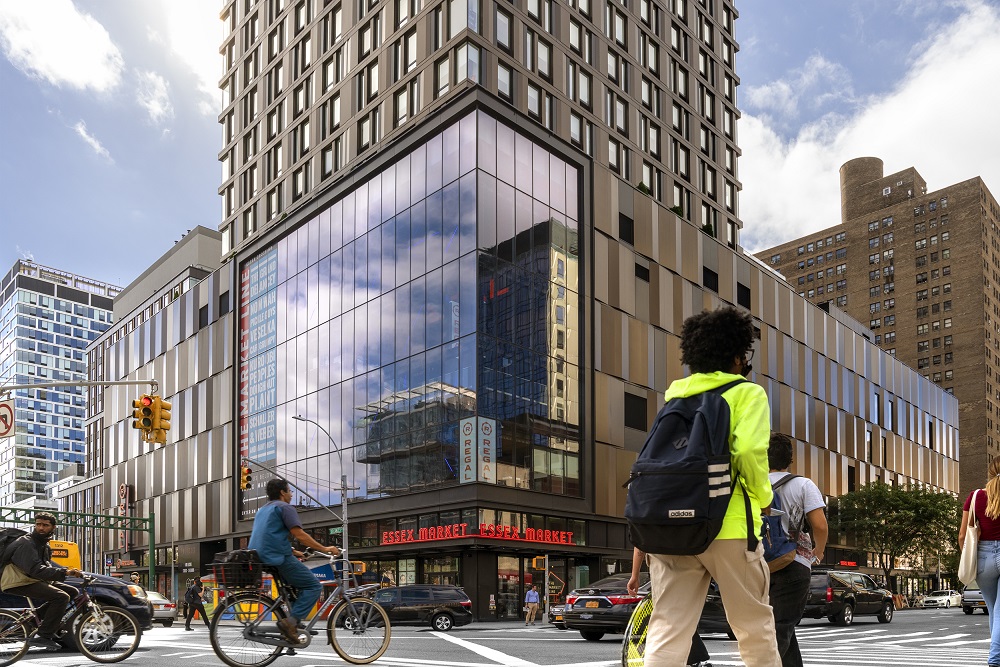
Essex Crossing, a 6-acre development in Manhattan co-developed by L+M Development Partners. (QuallsBenson image courtesy of LMXD)
That project is planned to include more than 1,000 units of rental and for-sale housing, over half of which will be permanent income-based units or senior housing. It’s also planned for over 700,000 square feet of commercial space, 350,000 square feet of office space, 100,000 square feet of community and cultural facility space, and 100,000 square feet of park and greenspace.
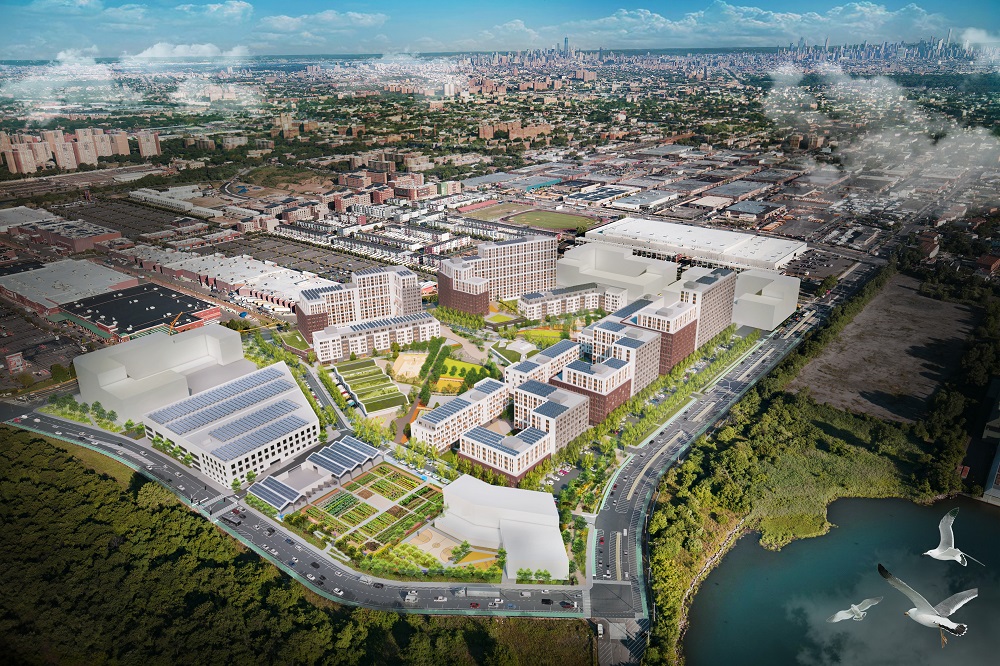
L+M is co-developing the 28-acre Alafia mixed-use project in Brooklyn. (Courtesy of L+M Development)
Other L+M projects include Alafia, a 28-acre site in Brooklyn with 2,400 low-income and supportive housing units, 30,000 square feet of health care space, open space, and commercial and community facility space.
Closer to Richmond, LMXD is developing Banner Lane, the first phase of a 7-acre redevelopment in D.C.’s Sursum Corda neighborhood. The phase consists of two buildings totaling 560 residential units.
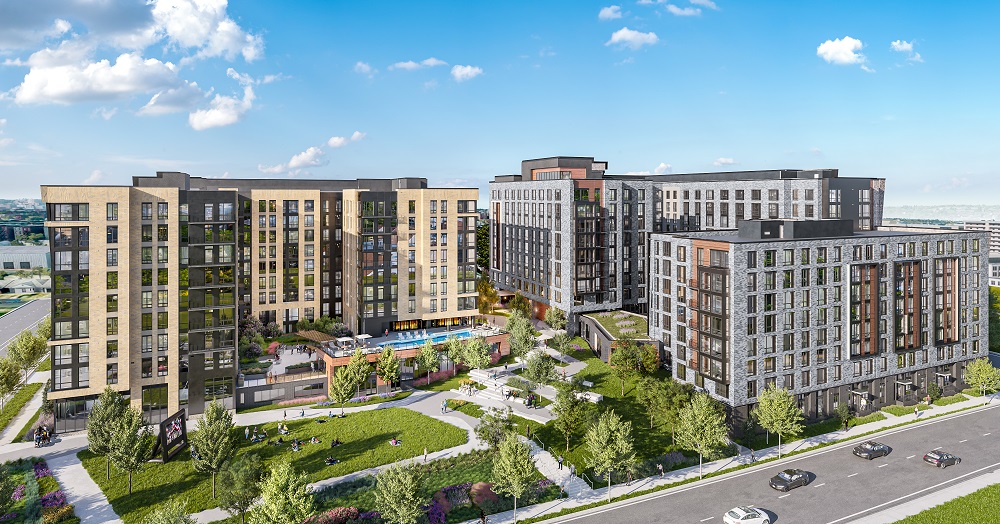
Banner Lane, the first phase of a 7-acre redevelopment that LMXD is leading in D.C.’s Sursum Corda neighborhood. (Toll Brothers Apartment Living image courtesy of LMXD)
Joining LMXD and Weller on the Diamond District team are ASM Global, a global venue management company that manages Richmond’s Dominion Energy Center and Altria Theater; and SAA | EVI, a minority-owned, Baltimore-based developer with an office in Richmond.
SAA | EVI owns St. Luke Apartments, a 496-unit complex near Laburnum Avenue and Meadowbridge Road that it purchased and began renovating three years ago. The firm also developed the 103-unit Nelson Kohl Apartments in Baltimore.
Rounding out the group is a design-build team consisting of Maryland-based Clark Construction, its Edgemoor Infrastructure & Real Estate development arm, and Populous, a design firm based in Kansas City, Missouri whose ballparks include Truist Park in Atlanta, Citi Field in New York and the new Yankee Stadium.
The group did not grant requests for an interview but provided a statement to BizSense through a representative. The statement said Weller and LMXD “are honored” to be among the six teams under consideration, adding that they “look forward to this opportunity to partner with the City of Richmond, Virginia Commonwealth University, the Richmond Flying Squirrels, and other local area stakeholders.”
“Our partnership with the City and community will catalyze the future growth of Richmond’s next vibrant and inclusive mixed-use neighborhood and entertainment district,” the statement continued. “We believe our team is uniquely positioned to execute the City’s goals with unparalleled experience in large-scale, public-private developments and an ethos centered around community integration, local hiring, women and minority business support, sustainability, and increased affordability.
“Drawing from the inspiration put forth in the Richmond 300 Master Plan, we believe that our project will emerge not only as one of the country’s premier master-planned entertainment districts and neighborhoods – but as a symbol of Richmond’s innovative future.”
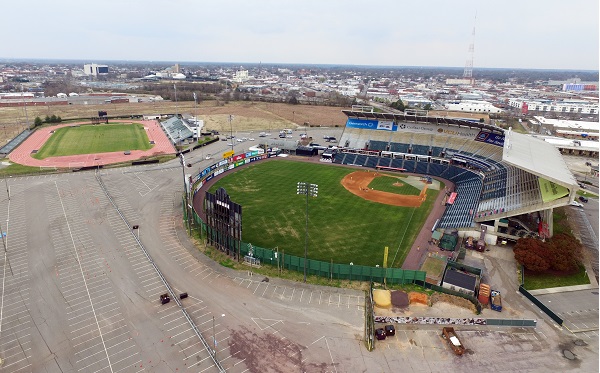
The area that makes up the Diamond District includes the namesake baseball stadium and nearby Sports Backers Stadium. (BizSense file images)
The city is looking for one or more teams to collaborate with on redeveloping the 67-acre site that’s been floated for redevelopment in starts and stops for over a decade.
Driving this latest effort in large part is a deadline set by Major League Baseball for all pro baseball venues to meet new facility standards by the start of the 2025 season. The Flying Squirrels has been promised a new ballpark since the Double-A club’s arrival in 2010.
Deemed unfeasible for renovation, the 37-year-old Diamond would be replaced with a new 10,000-capacity stadium that would anchor the larger mixed-use development. The city’s solicitation calls for office, residential, retail, a hotel and infrastructure upgrades. The residential component would consist of rental and for-sale homes targeted to a mix of income levels.
An evaluation panel is reviewing additional information that the six development teams were required to provide by April 25. The panel is aiming to narrow the field down to a shortlist of finalists, who could be announced as early as next week.
The finalists would be invited to submit proposals by June 6. City officials would then negotiate with one or more of the teams and make a final selection by the end of June.
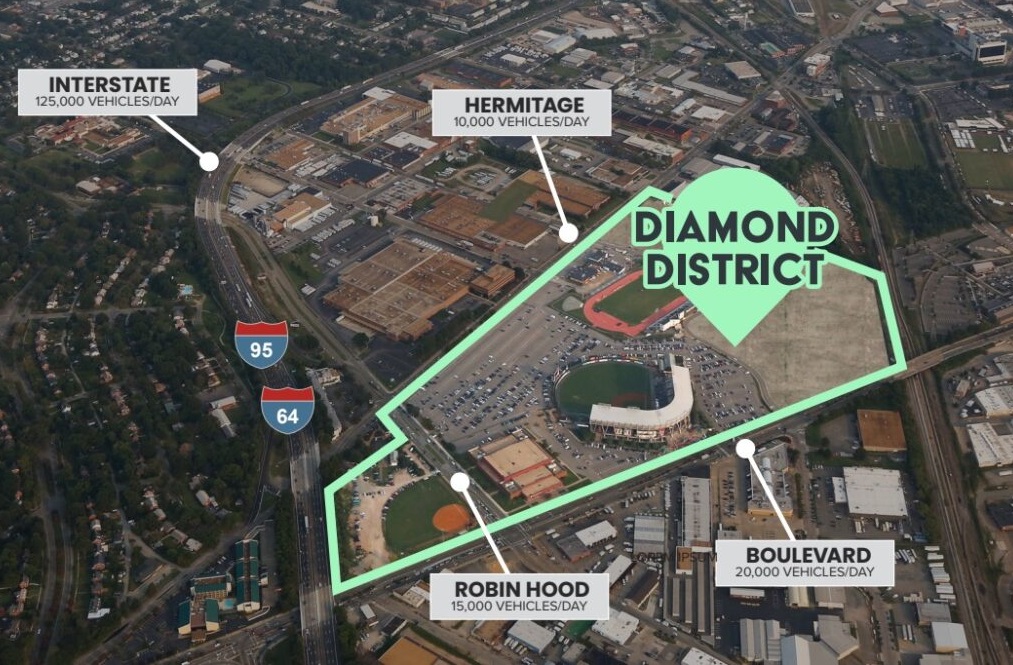
The 60-plus acres of the Diamond District are bordered by Arthur Ashe Boulevard, Hermitage Road, the interstate and the railroad tracks.
The other five teams that remain in contention are:
Diamond District Gateway Partners, consisting of local real estate investment firm Capital Square, D.C.-based developers Dantes Partners and Hoffman & Associates, Maryland-based real estate firm The Velocity Cos., architecture firms Baskervill and Pendulum, engineering firms VHB and Froehling & Robertson, and general contractors Clancy & Theys and Barton Malow.
MAG Partners, a New York City-based developer working with Seattle-based developer MacFarlane Partners, D.C.-based developer Jair Lynch Real Estate Partners, real estate investment firm MSquared, architecture firms AtelierTek and Woods Bagot, engineering firms Kimley-Horn and Thornton Tomasetti, sports venue developer CAA Icon, and placemaking and workforce firm C Space.
Richmond Community Development Partners, consisting of Houston-based Machete Group, developers JMA Ventures and Sterling Project Development, construction firm Gilbane, hotel management and advisory firm Retro Hospitality, architecture firm Hanbury, engineering firm VHB and planning nonprofit Storefront for Community Design.
RVA Diamond Partners, consisting of D.C.-based Republic Properties Corp., local developer Thalhimer Realty Partners, Chicago-based Loop Capital, stadium team DLR Group and JMI Sports, lead architect Skidmore, Owings & Merrill, hotel developer Capstone Development, and residential developers Pennrose, NixDev and Southside Community Development & Housing Corp.
Vision300 Partners LLC, including developers Freehold Communities, Greenstone Properties, KDC and Spy Rock Real Estate Group; local building firm Hourigan; housing nonprofit Better Housing Coalition, construction firm Canterbury Enterprises, Shamin Hotels, YMCA of Greater Richmond, Brookfield Asset Management, and Richmond-based Sports United Ltd.

Weller Development Co. is the lead developer on Port Covington, a 235-acre mixed-use development on South Baltimore’s waterfront. (Courtesy of Weller Development)
Rounding out the field of development teams vying for Richmond’s Diamond District project is a group led by two firms experienced in mixed-use developments primarily in New York and Baltimore, including the latter’s massive Port Covington development.
Baltimore-based Weller Development Co. and New York-based LMXD are driving one of the six teams that remain in contention for the 67-acre mixed-use development that’s to include a new baseball stadium to replace The Diamond.
Weller, a 5-year-old firm founded by 20-year developer Marc Weller, is the lead developer on Port Covington, a 235-acre project on South Baltimore’s waterfront that’s planned for up to 18 million square feet, according to the company’s website.
The massive development, with 2½ miles of waterfrontage and immediate access to Interstate 95, is planned to include residential, office and retail uses, along with a hotel, restaurants, entertainment, athletic facilities, a business incubator, cultural space, marinas, piers and 40 acres of public parks and greenspace.
More than 1 million square feet of Port Covington is currently under development, according to Weller, which is working on the project with investment firm Sagamore Ventures and Goldman Sachs’ Urban Investment Group.
Weller’s other Baltimore-area projects include the Sagamore Pendry Baltimore hotel, Sagamore Spirit Distillery, Rye Street Tavern and City Garage, an innovation hub converted from a city bus depot. The company also manages the Reston National golf course in Northern Virginia and developed the 3150 M Street NW retail building in Washington, D.C.’s Georgetown neighborhood.
LMXD, affiliated with New York-based L+M Development Partners, was recently launched as a development and investment affiliate focused on mixed-income and mixed-use communities. The launch coincided with L+M’s appointment of Lisa Gomez as CEO earlier this year, according to its website.
L+M, a 38-year-old firm founded by Ron Moelis and Sandy Loewentheil, is one of several firms involved in developing Essex Crossing, a 6-acre, $1.9 billion development on the Lower East Side of Manhattan.

Essex Crossing, a 6-acre development in Manhattan co-developed by L+M Development Partners. (QuallsBenson image courtesy of LMXD)
That project is planned to include more than 1,000 units of rental and for-sale housing, over half of which will be permanent income-based units or senior housing. It’s also planned for over 700,000 square feet of commercial space, 350,000 square feet of office space, 100,000 square feet of community and cultural facility space, and 100,000 square feet of park and greenspace.

L+M is co-developing the 28-acre Alafia mixed-use project in Brooklyn. (Courtesy of L+M Development)
Other L+M projects include Alafia, a 28-acre site in Brooklyn with 2,400 low-income and supportive housing units, 30,000 square feet of health care space, open space, and commercial and community facility space.
Closer to Richmond, LMXD is developing Banner Lane, the first phase of a 7-acre redevelopment in D.C.’s Sursum Corda neighborhood. The phase consists of two buildings totaling 560 residential units.

Banner Lane, the first phase of a 7-acre redevelopment that LMXD is leading in D.C.’s Sursum Corda neighborhood. (Toll Brothers Apartment Living image courtesy of LMXD)
Joining LMXD and Weller on the Diamond District team are ASM Global, a global venue management company that manages Richmond’s Dominion Energy Center and Altria Theater; and SAA | EVI, a minority-owned, Baltimore-based developer with an office in Richmond.
SAA | EVI owns St. Luke Apartments, a 496-unit complex near Laburnum Avenue and Meadowbridge Road that it purchased and began renovating three years ago. The firm also developed the 103-unit Nelson Kohl Apartments in Baltimore.
Rounding out the group is a design-build team consisting of Maryland-based Clark Construction, its Edgemoor Infrastructure & Real Estate development arm, and Populous, a design firm based in Kansas City, Missouri whose ballparks include Truist Park in Atlanta, Citi Field in New York and the new Yankee Stadium.
The group did not grant requests for an interview but provided a statement to BizSense through a representative. The statement said Weller and LMXD “are honored” to be among the six teams under consideration, adding that they “look forward to this opportunity to partner with the City of Richmond, Virginia Commonwealth University, the Richmond Flying Squirrels, and other local area stakeholders.”
“Our partnership with the City and community will catalyze the future growth of Richmond’s next vibrant and inclusive mixed-use neighborhood and entertainment district,” the statement continued. “We believe our team is uniquely positioned to execute the City’s goals with unparalleled experience in large-scale, public-private developments and an ethos centered around community integration, local hiring, women and minority business support, sustainability, and increased affordability.
“Drawing from the inspiration put forth in the Richmond 300 Master Plan, we believe that our project will emerge not only as one of the country’s premier master-planned entertainment districts and neighborhoods – but as a symbol of Richmond’s innovative future.”

The area that makes up the Diamond District includes the namesake baseball stadium and nearby Sports Backers Stadium. (BizSense file images)
The city is looking for one or more teams to collaborate with on redeveloping the 67-acre site that’s been floated for redevelopment in starts and stops for over a decade.
Driving this latest effort in large part is a deadline set by Major League Baseball for all pro baseball venues to meet new facility standards by the start of the 2025 season. The Flying Squirrels has been promised a new ballpark since the Double-A club’s arrival in 2010.
Deemed unfeasible for renovation, the 37-year-old Diamond would be replaced with a new 10,000-capacity stadium that would anchor the larger mixed-use development. The city’s solicitation calls for office, residential, retail, a hotel and infrastructure upgrades. The residential component would consist of rental and for-sale homes targeted to a mix of income levels.
An evaluation panel is reviewing additional information that the six development teams were required to provide by April 25. The panel is aiming to narrow the field down to a shortlist of finalists, who could be announced as early as next week.
The finalists would be invited to submit proposals by June 6. City officials would then negotiate with one or more of the teams and make a final selection by the end of June.

The 60-plus acres of the Diamond District are bordered by Arthur Ashe Boulevard, Hermitage Road, the interstate and the railroad tracks.
The other five teams that remain in contention are:
Diamond District Gateway Partners, consisting of local real estate investment firm Capital Square, D.C.-based developers Dantes Partners and Hoffman & Associates, Maryland-based real estate firm The Velocity Cos., architecture firms Baskervill and Pendulum, engineering firms VHB and Froehling & Robertson, and general contractors Clancy & Theys and Barton Malow.
MAG Partners, a New York City-based developer working with Seattle-based developer MacFarlane Partners, D.C.-based developer Jair Lynch Real Estate Partners, real estate investment firm MSquared, architecture firms AtelierTek and Woods Bagot, engineering firms Kimley-Horn and Thornton Tomasetti, sports venue developer CAA Icon, and placemaking and workforce firm C Space.
Richmond Community Development Partners, consisting of Houston-based Machete Group, developers JMA Ventures and Sterling Project Development, construction firm Gilbane, hotel management and advisory firm Retro Hospitality, architecture firm Hanbury, engineering firm VHB and planning nonprofit Storefront for Community Design.
RVA Diamond Partners, consisting of D.C.-based Republic Properties Corp., local developer Thalhimer Realty Partners, Chicago-based Loop Capital, stadium team DLR Group and JMI Sports, lead architect Skidmore, Owings & Merrill, hotel developer Capstone Development, and residential developers Pennrose, NixDev and Southside Community Development & Housing Corp.
Vision300 Partners LLC, including developers Freehold Communities, Greenstone Properties, KDC and Spy Rock Real Estate Group; local building firm Hourigan; housing nonprofit Better Housing Coalition, construction firm Canterbury Enterprises, Shamin Hotels, YMCA of Greater Richmond, Brookfield Asset Management, and Richmond-based Sports United Ltd.


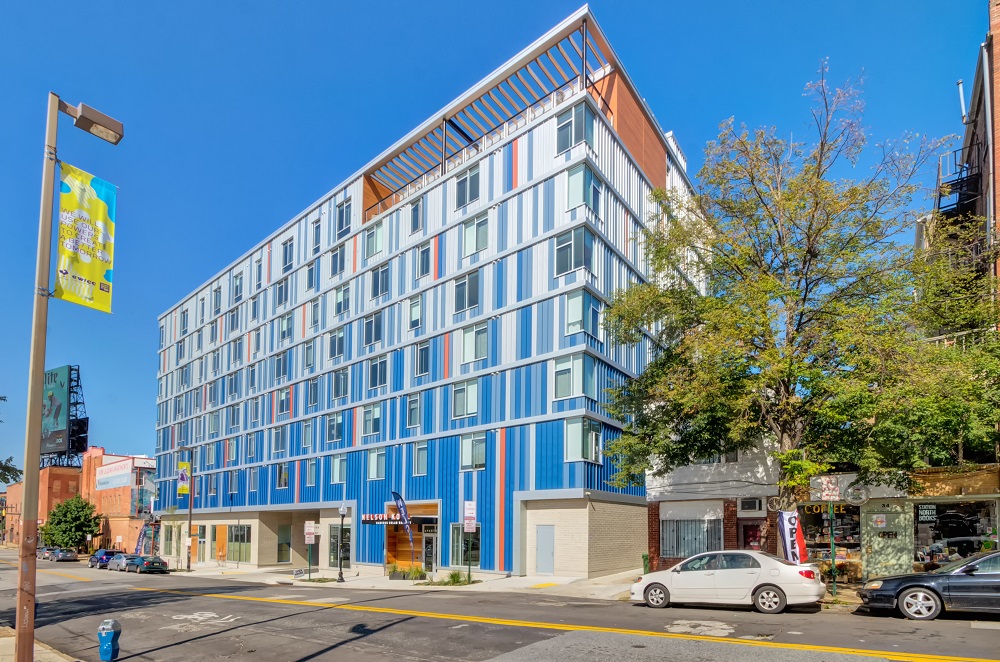
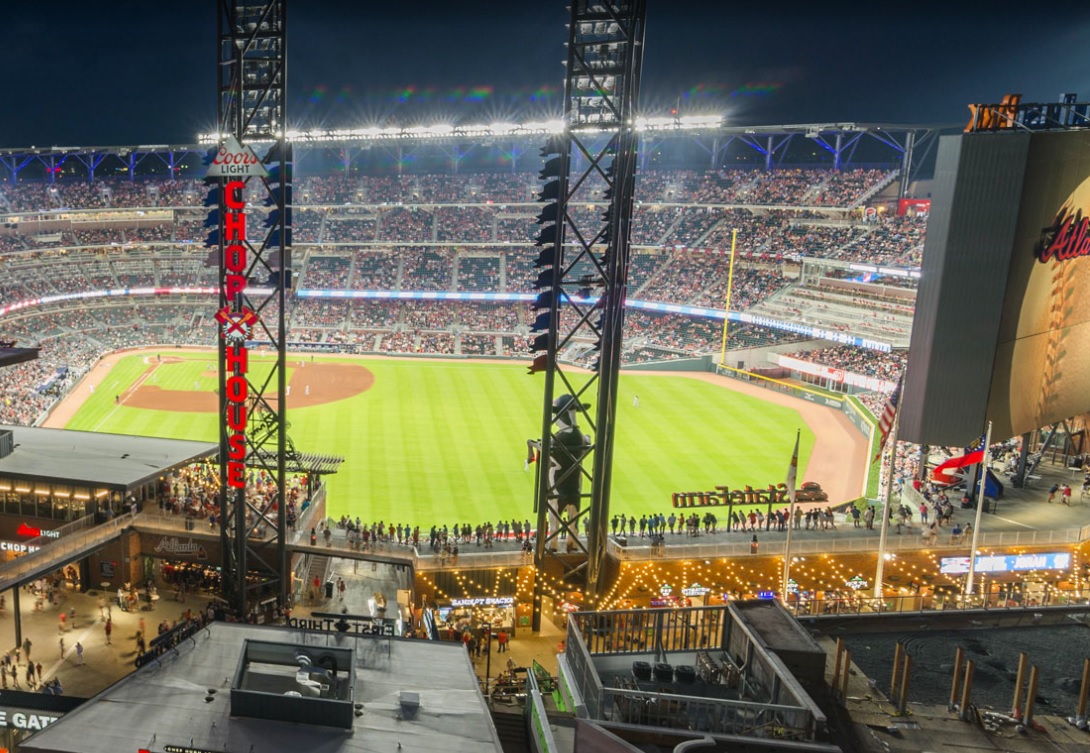


Yet another team with the “Wow” factor. The devil is in the details though and it all comes down to the level of public risk for private reward. Which of these extremely well-off and successful development teams will limit the future exposure of a TIF geographic area to pay off its development bonds? The TIF on its own area is inevitable as I see it because of public benefits within each proposal, but will the applicants attempt to spread the boundary through Scott’s Addition, the Fan, and the Museum District or northward into those residential areas?
Resume on par with the rest, however there is a notable limited local presence with this group. It’s like watching the profit fly out of Richmond and Virginia. A management group and a one small project developer represent the local, but both are headquartered outside of Virginia. Not even a local architect, or one with a Richmond office to guide the projects connection to what makes Richmond Richmond… That’s an immediate no from me.
It’s this kind of thinking that keeps Richmond relatively unsuccessful.
After seeing who Richmond selected for the casino, I have zero confidence they’ll select the best developer for this as well. Or that they’ll actually pull the trigger finally on a stadium.
Risk comes before reward (profit). In my opinion the major question is how does the new stadium get financed, and what will it cost! 75 million dollars is a lot of money for a 10,000 seat stadium. Everyone needs to be reminded that the Flying Squirrels attendance is almost always the highest in their league and averaged 6267/per game from 2010 to 2019. In my opinion a 7500 seat stadium , such as Oneok Field,( capacity 7833) in Tulsa Oklahoma, home of the Tulsa Drillers would be a better fit for the Squirrels, and would reduce the final cost. Oneok… Read more »
This is a great point. I always thought that a stadium that looks mostly full instead of mostly empty is a better time. It adds to the atmosphere!!. Keep it to scale. A perfect example is VCU basketball going from the Coliseum to Siegel Center. And I don’t think Duke has any plans to build a larger arena, no matter how many championships are won.
The flip side of that equation would be if you can average 6200 in probably the worst stadium in AA baseball how many could you average in a new one? Certainly the number of corporate tickets would go up with a new venue. It may not last forever but I wouldn’t be surprised to see a 30% jump in attendance for the first five years with a brand new stadium. Especially if it was done well with restaurants and night life around it. Another point is look at the population growth. When the Diamond was built we had about 800K… Read more »
There is a reason why it’s going to be 10,000 seats. I have read from people who live in Rochester New York that the plan is to make the rochester red wings a double a team and make the flying squirrels to triple a where we should be and that the nationals would move their triple a affiliate to Richmond with the flying squirrels. They have been wanting Richmond for years now so that when a player gets called up to the show just have to go up 95 to dc to nationals park. Pretty much every mlb team now… Read more »
I always wondered why the Nats didn’t push for Richmond when the R-Braves left town. Their only AAA team was in New Orleans in 2005
I can’t fathom people caring about RVA having a AAA or AA team, as opposed to having a team that provides a fun experience.
Also shipping the flying Squirrels out is a crappy way to treat a team that has lived on scraps and broken promises and done amazingly well
They won’t be leaving just upgrading to triple a level. They will still be the fun experience just the final level before reaching the majors. Nothing will change other than the level of play from double a to triple a where we should be all along, it will just be the nationals triple a. Lots of nats fans here now since relocating the expos from Montreal. It will be a way bigger draw than a team from the west coast being the San Francisco giants.
Hopefully one of the developers will be able to loop in a plan for that dump of a hotel across from The Hermitage. And not one mention of the eyesore that is the bus station in one of these articles. We’re all looking forward to a new stadium and this little nook of town becoming successful.
LOL the hotel will probably fall down on it’s own any day now.
But i really feel the Greyhound station, the Pulse bus and the train need to be connected as seamlessly as possible.
Wow! I have said this before, and it is even more clear to me now, that the number of high quality groups proposing for this site is a great sign of the potential of this site and developers’ perceptions of Richmond’s potential to not be a place merely mired in provincial thinking and in-fighting that always lets opportunities and the future pass it by in favor of loving its controversal past and prefering the way things have always been done to proven new realities. My biggest fear is that an inferior group or proposal that invests less and builds mediocrely… Read more »